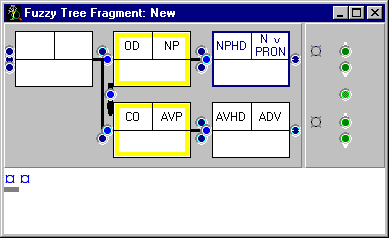Fuzzy Tree Fragments
This is a simple Fuzzy Tree Fragment, or FTF. We believe that FTFs are intuitive grammatical queries. A whole section of this website explains FTFs in more detail.

The idea is that you use a simplified fragment of a grammatical tree to specify a search across the corpus.
FTFs contain nodes, words, links and edges. Nodes and words match the nodes and words in corpus trees. Links and edges specify relationships between nodes and words.
FTFs are very similar to syntactic trees in the corpus. Each node contains a category part, specifying the element's type, including its word class; a function part, defining the node's relationship in the phrase or clause that it is part of; and a set of features which refine the category.
There are three ways of constructing an FTF.
- You can build an FTF from scratch with the editor. This is where you make a very abstract query more specific: what is known as “top-down” editing.
- Alternatively, you can make an FTF from a tree in the corpus working from the bottom, up. ICECUP 3.1 lets you simply mark nodes in a tree and these nodes are incorporated into the FTF matching those nodes.
- You can also use Text Fragment and simple Node searches to make simple FTFs.
ICECUP 3.1 also enhances Fuzzy Tree Fragments to make them more expressive. The main way this is done is with logic. For example, the element at the top right in the figure above is defined as “N v PRON” - noun or pronoun.
In this FTF, all the links are immediate, that is, the nodes they match against must be directly connected to one another in the specified arrangement. The direct object : object complement relationship is also ordered.
More information on Fuzzy Tree Fragments and their topology is on the following FTF pages.
![]() Fuzzy Tree Fragments
Fuzzy Tree Fragments
![]() FTF links and edges
FTF links and edges
Fuzzy Tree Fragments work on parsed corpora. To see the results of applying an FTF we provide new ways of concordancing the corpus.
This page last modified 7 July, 2020 by Survey Web Administrator.